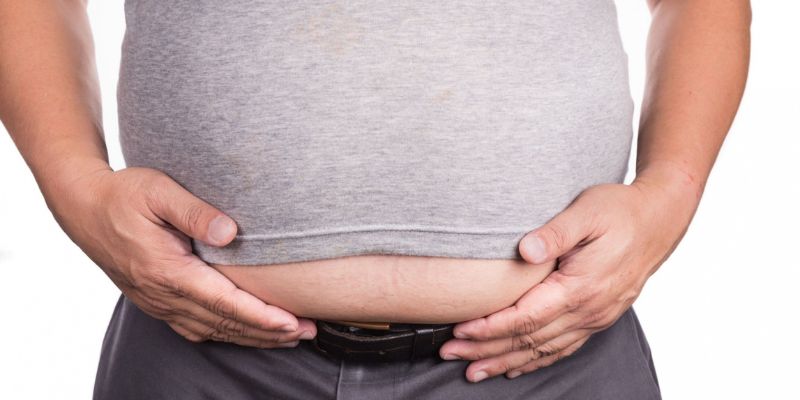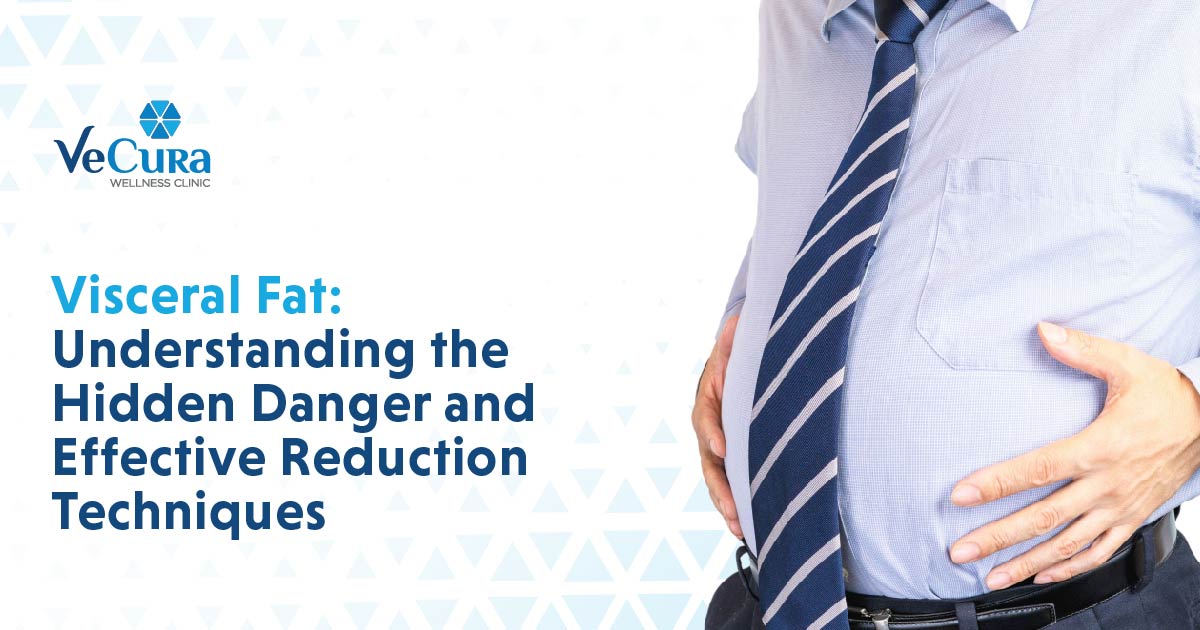Excess body fat is a growing concern in today’s sedentary and fast-paced lifestyle. While many focus on the visible effects of weight gain, such as body shape and appearance, there is a deeper, hidden danger lurking within visceral fat. But don’t worry, it’s not impossible to get rid of it!
Unlike subcutaneous fat, visceral fat accumulates around vital organs inside your body and poses a significant risk to your health. In this blog, we delve into the science behind visceral body fat, explore its detrimental effects, and provide effective reduction techniques to help you achieve your goal faster and better.
Keep reading to know more about it so you can keep yourself safe and healthy!
What Exactly is Visceral Body Fat?
Visceral fat, often referred to as intra-abdominal fat, is a type of fat that builds up around vital organs like the liver, pancreas, and intestines deep inside the abdominal cavity. Unlike subcutaneous fat, which lies just beneath the skin, visceral fat is not visible to the naked eye.
It acts as a cushion to protect the organs, but when it rises above healthy levels, it causes serious problems. Visceral fat has a high metabolic rate and releases harmful chemicals that cause inflammation and disrupt regular bodily functions.
Its excessive accumulation has been linked to increased risks of cardiovascular disease, type 2 diabetes, insulin resistance, and other health complications.

Symptoms and Causes of Visceral Fat
Symptoms of visceral fat may not be immediately apparent, as it is hidden around your organs in the body. However, certain signs and risk factors can indicate its presence.
- One common sign is increased waist circumference or an “apple-shaped” body, where fat accumulates in the midsection.
- Excessive blood pressure, excessive blood sugar, abnormal cholesterol levels, and insulin resistance are a few other symptoms.
- Additionally, people with extra visceral fat may be more likely to develop metabolic syndrome, type 2 diabetes, some malignancies, and cardiovascular disease.

Visceral Fat Builds Up Due To Various Factors.
- The main causes include a sedentary lifestyle and a lack of exercise, which encourage overall weight gain and fat storage.
- Excess visceral fat can also result from poor dietary choices, particularly those high in refined carbs, added sugars, and unhealthy fats.
- Modifications in hormone levels, such as imbalances in cortisol and oestrogen, may also be at play.
- Furthermore, genetic factors can also affect how fat is distributed throughout the body.
- Age also matters since visceral fat accumulates as we age because our muscles deteriorate and our metabolism slows down.
- Lastly, increased visceral fat accumulation has been linked to prolonged stress and insufficient sleep.
Understanding the symptoms and causes of visceral fat is essential for early detection and effective management. By addressing the underlying causes and implementing lifestyle changes, individuals can reduce visceral fat levels before it becomes a threat!
Understanding Its Hidden Risks And Dangers

When it comes to visceral fat, there are some significant risks and dangers associated with it that affect the overall health of your body.
- Considered one of the major risks, visceral fat is significantly correlated with Cardiovascular Disease.
The harmful substances that are released by fat cells encourage inflammation and play an important role in the rise of heart attacks, strokes, and high blood pressure.
- Visceral fat is also directly related to insulin resistance, a risk factor for Type 2 Diabetes.
Fatty acids are released from fat cells into the bloodstream, affecting the function of insulin and raising blood sugar levels. This can eventually lead to the onset of diabetes.
- In addition to cardiovascular issues, visceral fat is also linked to Metabolic Syndrome– a group of illnesses that include high blood pressure, excessive cholesterol levels, and extra belly fat.
Together, these factors significantly increase the risk of heart disease and stroke.
- Additionally, recent studies point to a possible link between visceral fat and specific cancers, including colorectal, breast, and pancreatic cancer.
Although the exact mechanisms are not fully understood, inflammation and hormonal imbalances caused by visceral fat are believed to play a role.
Understanding the risks and dangers associated with visceral fat highlights the urgency of addressing this hidden threat.
How To Reduce Visceral Fat: Effective Reduction Techniques

Reducing visceral fat is crucial for improving overall health and reducing the risk of various diseases. Here are some effective techniques to help you reduce it:
- Regular Exercise: Make sure you get 150 minutes of moderate-intensity exercise or 75 minutes of vigorous-intensity exercise each week. Include strength training exercises to build muscle, as increasing muscle mass can help burn calories and lower visceral fat.
- Healthy Diet: Adopt a well-balanced diet high in whole foods such as fruits and vegetables, lean meats, whole grains, and healthy fats. Sugary and processed foods should be avoided because they contribute to increased visceral fat.
- Reduce Stress: Chronic stress can raise cortisol levels, causing visceral fat to accumulate. Incorporate stress-reduction practises such as meditation, yoga, deep breathing exercises, or hobbies that allow you to relax and unwind.
- Get Sufficient Sleep: Sleep deprivation disturbs the hormonal balance and might increase hunger and cravings for junk food. Aim for 7-9 hours of excellent sleep per night to promote a healthy metabolism and minimise visceral fat.
- Stay Hydrated: Drinking enough water can enhance metabolism, encourage feelings of fullness, and support overall weight loss attempts. Replace sugary beverages with water and make it a habit to stay hydrated throughout the day.
- Limit Alcohol Consumption: Excessive alcohol consumption has been associated with increased visceral fat deposition. Reduce or prevent alcohol consumption to reduce the buildup of visceral fat.
- Monitor Your Waist Circumference: Keep track of your waist circumference regularly. Generally, a waist circumference above 40 inches (102 cm) in men and 35 inches (88 cm) in women indicates an increased risk of visceral fat-related health issues.
Remember, reducing visceral fat takes time and consistency. Combining these techniques with a healthy lifestyle can effectively reduce visceral fat and improve your overall well-being.
Choose VeCura Wellness For Healthy Weight Loss!
VeCura Wellness presents – The Premier Plus Weight Loss program, a reliable and effortless method for shedding pounds. Our program utilises a combination of treatments that boost metabolism, facilitate calorie burning, and help in body toning.
Experience a personalised consultation with our team of wellness experts, who will provide expert guidance throughout your sustainable weight loss journey. With VeCura Wellness, you can expect minimal downtime after each treatment session.
VeCura Wellness offers personalised weight loss, inch loss, and body contouring treatments at their clinics across major cities in India:
- Pondicherry
- Chennai – T Nagar
- Chennai – Anna Nagar
- Chennai – OMR
- Chennai – Porur
- Chennai – Chromepet
- Coimbatore
- Trichy
- Madurai
- Salem
- Vellore
- Erode
- Malakpet
- AS Rao Nagar
- Medipally
- Kukatpally
- Visakhapatnam
- Vijayawada
- Tirupati
Why Choose VeCura Wellness?
- Safe and scientifically proven treatments,
- Personalised consultations tailored to your needs, and
- A caring approach focused on session-oriented care.
Conclusion
As we conclude, we now know that it is crucial to recognise the importance of taking proactive steps towards reducing visceral fat. By understanding the risks associated with visceral fat accumulation, we empower ourselves to make informed choices about our health. Armed with effective techniques and lifestyle modifications, you can now combat this threat and pave the way for a healthier future.
Remember, reducing visceral fat is not only about achieving a slimmer waistline but also safeguarding your overall well-being. And if you are in need of expert advice and guidance, VeCura Wellness is the place to go!
Note: To explore more engaging content and stay connected, feel free to visit VeCura Wellness YouTube channel for exciting videos, insightful discussions, and much more.
Visceral Body Fat: FAQs
- What is the best way to dissolve visceral fat?
Diet and weight loss are the best ways to minimise visceral fat. Compared to hip fat, visceral fat reacts better to diet and exercise. Additionally, regular exercise can prevent visceral fat from recurring.
- What is the key to losing visceral fat?
Proper exercise, a nutritious diet, intermittent fasting, better sleep, less stress, and alcohol restriction are all effective ways to reduce visceral fat. You can follow your usual weight loss plan, like diet and exercise, to lose visceral fat.
- What foods burn visceral fat?
Meat, fish, eggs, dairy, lentils, and whey protein are a few excellent sources of protein that can help reduce your weight and visceral fat. Increase your intake of foods high in protein to help reduce visceral fat.
- What exercises reduce visceral fat?
Exercises that can help reduce visceral fat include aerobic activities like brisk walking, running, and cycling and strength training exercises like lifting weights.
- Does walking reduce visceral fat?
Yes, walking is one of the best ways to reduce visceral fat. The increased energy expenditure produced during brisk walking can help you reduce visceral fat effectively.









0 Comments